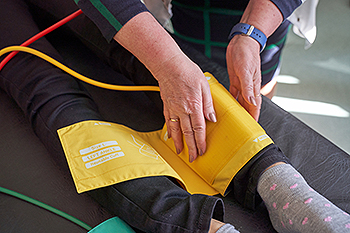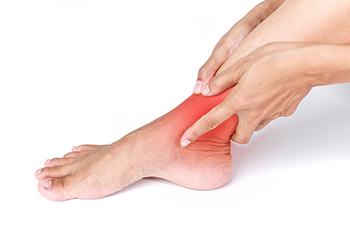Items filtered by date: December 2021
Why Is My Ankle Painful?
The ankle is a joint made up of many components, such as leg and foot bones, ligaments, nerves, cartilage, tendons, and muscles. As a complex joint that is responsible for the foot’s up-and-down movement, it is prone injury in various ways, often causing pain. Ankle sprains and strains are the most common form of ankle pain. Other possible reasons for ankle pain include Achilles tendonitis, a ruptured Achilles tendon, nerve damage, a tumor, and different forms of arthritis—such as gout, osteoarthritis and rheumatoid arthritis. Along with pain, you may experience redness, bruising and numbness, or tingling, and your ankle may feel weak or stiff. You may also have difficulty putting weight on the ankle. Podiatrists frequently deal with all matters of ankle pain, so it may be wise to make an appointment if you are experiencing any of these symptoms in order to get the proper diagnosis treatment.
Ankle pain can be caused by a number of problems and may be potentially serious. If you have ankle pain, consult with Jim Maxka, DPM from South Penn Foot & Ankle Associates. Our doctor will assess your condition and provide you with quality foot and ankle treatment.
Ankle pain is any condition that causes pain in the ankle. Due to the fact that the ankle consists of tendons, muscles, bones, and ligaments, ankle pain can come from a number of different conditions.
Causes
The most common causes of ankle pain include:
- Types of arthritis (rheumatoid, osteoarthritis, and gout)
- Ankle sprains
- Broken ankles
- Achilles tendinitis
- Achilles tendon rupture
- Stress fractures
- Bursitis
- Tarsal tunnel syndrome
- Plantar fasciitis
Symptoms
Symptoms of ankle injury vary based upon the condition. Pain may include general pain and discomfort, swelling, aching, redness, bruising, burning or stabbing sensations, and/or loss of sensation.
Diagnosis
Due to the wide variety of potential causes of ankle pain, podiatrists will utilize a number of different methods to properly diagnose ankle pain. This can include asking for personal and family medical histories and of any recent injuries. Further diagnosis may include sensation tests, a physical examination, and potentially x-rays or other imaging tests.
Treatment
Just as the range of causes varies widely, so do treatments. Some more common treatments are rest, ice packs, keeping pressure off the foot, orthotics and braces, medication for inflammation and pain, and surgery.
If you have any questions, please feel free to contact our office located in Hanover, PA . We offer the newest diagnostic and treatment technologies for all your foot care needs.
Sesamoid Fracture Treatment
The sesamoids are two tiny, pea-shaped bones located in the ball of the foot, just beneath the big toe. These small bones allow the big toe to move normally and provide leverage when pushing off the big toe while walking or running. The sesamoids can be fractured during physical activities like running, hiking, or playing sports. Broken sesamoid bones cause deep, aching or sharp pain in the ball of the foot behind the big toe. The surrounding area may be red or swollen. Sesamoid fractures are generally diagnosed through X-rays. Treatment may include wearing flat, rigid shoes specially designed to hold bones in place while they heal, wearing orthotics, and taking over-the-counter medications to manage pain. For more information about sesamoid injuries, please consult with a podiatrist.
Sesamoiditis is an unpleasant foot condition characterized by pain in the balls of the feet. If you think you’re struggling with sesamoiditis, contact Jim Maxka, DPM of South Penn Foot & Ankle Associates. Our doctor will treat your condition thoroughly and effectively.
Sesamoiditis
Sesamoiditis is a condition of the foot that affects the ball of the foot. It is more common in younger people than it is in older people. It can also occur with people who have begun a new exercise program, since their bodies are adjusting to the new physical regimen. Pain may also be caused by the inflammation of tendons surrounding the bones. It is important to seek treatment in its early stages because if you ignore the pain, this condition can lead to more serious problems such as severe irritation and bone fractures.
Causes of Sesamoiditis
- Sudden increase in activity
- Increase in physically strenuous movement without a proper warm up or build up
- Foot structure: those who have smaller, bonier feet or those with a high arch may be more susceptible
Treatment for sesamoiditis is non-invasive and simple. Doctors may recommend a strict rest period where the patient forgoes most physical activity. This will help give the patient time to heal their feet through limited activity. For serious cases, it is best to speak with your doctor to determine a treatment option that will help your specific needs.
If you have any questions please feel free to contact our office located in Hanover, PA . We offer the newest diagnostic and treatment technologies for all your foot and ankle needs.
Arthritis Can Cause Pain in the Feet and Ankles
Ways to Treat Peripheral Vascular Disease
 When someone experiences peripheral vascular disease, (also called peripheral artery disease, or PAD), the primary cause is a decrease of blood flow to a body part other than the brain or heart. This is usually caused by a buildup of fatty deposits in the artery. Most commonly it affects the legs, feet, and toes causing pain, cramping, numbness, tingling, coldness, and wounds that won’t heal. If left untreated it can lead to more serious conditions, including gangrene. Unfortunately, many symptoms often are noticed only after the condition has become serious. Risk factors include diabetes, obesity, smoking, and sedentary living. Several actions can help reduce symptoms, including managing diabetes and high blood pressure, losing weight, ceasing smoking, exercising regularly, and eating low-fat, high-fiber foods. If pain continues or gets worse, it is suggested that you consult a podiatrist who can review medical treatment and surgical procedures available to widen the blood vessels.
When someone experiences peripheral vascular disease, (also called peripheral artery disease, or PAD), the primary cause is a decrease of blood flow to a body part other than the brain or heart. This is usually caused by a buildup of fatty deposits in the artery. Most commonly it affects the legs, feet, and toes causing pain, cramping, numbness, tingling, coldness, and wounds that won’t heal. If left untreated it can lead to more serious conditions, including gangrene. Unfortunately, many symptoms often are noticed only after the condition has become serious. Risk factors include diabetes, obesity, smoking, and sedentary living. Several actions can help reduce symptoms, including managing diabetes and high blood pressure, losing weight, ceasing smoking, exercising regularly, and eating low-fat, high-fiber foods. If pain continues or gets worse, it is suggested that you consult a podiatrist who can review medical treatment and surgical procedures available to widen the blood vessels.
Peripheral artery disease can pose a serious risk to your health. It can increase the risk of stroke and heart attack. If you have symptoms of peripheral artery disease, consult with Jim Maxka, DPM from South Penn Foot & Ankle Associates. Our doctor will assess your condition and provide you with quality foot and ankle treatment.
Peripheral artery disease (PAD) is when arteries are constricted due to plaque (fatty deposits) build-up. This results in less blood flow to the legs and other extremities. The main cause of PAD is atherosclerosis, in which plaque builds up in the arteries.
Symptoms
Symptoms of PAD include:
- Claudication (leg pain from walking)
- Numbness in legs
- Decrease in growth of leg hair and toenails
- Paleness of the skin
- Erectile dysfunction
- Sores and wounds on legs and feet that won’t heal
- Coldness in one leg
It is important to note that a majority of individuals never show any symptoms of PAD.
Diagnosis
While PAD occurs in the legs and arteries, Podiatrists can diagnose PAD. Podiatrists utilize a test called an ankle-brachial index (ABI). An ABI test compares blood pressure in your arm to you ankle to see if any abnormality occurs. Ultrasound and imaging devices may also be used.
Treatment
Fortunately, lifestyle changes such as maintaining a healthy diet, exercising, managing cholesterol and blood sugar levels, and quitting smoking, can all treat PAD. Medications that prevent clots from occurring can be prescribed. Finally, in some cases, surgery may be recommended.
If you have any questions, please feel free to contact our office located in Hanover, PA . We offer the newest diagnostic and treatment technologies for all your foot care needs.
Understanding Tarsal Tunnel Syndrome
On the inside of the ankle lies a narrow passageway created by soft tissue and bone, called the tarsal tunnel. Traveling through the tarsal tunnel are tendons, blood vessels, and nerves—including the tibial nerve. This nerve can become compressed within the narrow space of the tarsal tunnel by a variety of conditions that take up space within it. These conditions include lesions or masses, enlarged veins, benign bony growths, and tumors of nerve fibers or ganglion cells. Certain injuries or trauma, as well as having flat feet can contribute to the development of tarsal tunnel syndrome. Tarsal tunnel syndrome can cause pain, tingling, or burning anywhere on the tibial nerve, which runs from the ankle up through the back of the leg. If you believe you may have tarsal tunnel syndrome, schedule an appointment with a podiatrist who will examine you, and may also use nerve tests and imaging to help diagnose the issue. Treatment for tarsal tunnel syndrome may include icing, resting, anti-inflammatory medicines, custom orthotics, and physical therapy. More severe cases may require steroid injections or even surgery to increase space within the tunnel and reduce pressure on the nerve.
Tarsal tunnel syndrome can be very uncomfortable to live with. If you are experiencing tarsal tunnel syndrome, contact Jim Maxka, DPM of South Penn Foot & Ankle Associates. Our doctor can provide the care you need to keep you pain-free and on your feet.
Tarsal Tunnel Syndrome
Tarsal tunnel syndrome, which can also be called tibial nerve dysfunction, is an uncommon condition of misfiring peripheral nerves in the foot. The tibial nerve is the peripheral nerve in the leg responsible for sensation and movement of the foot and calf muscles. In tarsal tunnel syndrome, the tibial nerve is damaged, causing problems with movement and feeling in the foot of the affected leg.
Common Cause of Tarsal Tunnel Syndrome
- Involves pressure or an injury, direct pressure on the tibial nerve for an extended period of time, sometimes caused by other body structures close by or near the knee.
- Diseases that damage nerves, including diabetes, may cause tarsal tunnel syndrome.
- At times, tarsal tunnel syndrome can appear without an obvious cause in some cases.
The Effects of Tarsal Tunnel Syndrome
- Different sensations, an afflicted person may experience pain, tingling, burning or other unusual sensations in the foot of the affected leg.
- The foot muscles, toes and ankle become weaker, and curling your toes or flexing your foot can become difficult.
- If condition worsens, infections and ulcers may develop on the foot that is experiencing the syndrome.
A physical exam of the leg can help identify the presence of tarsal tunnel syndrome. Medical tests, such as a nerve biopsy, are also used to diagnose the condition. Patients may receive physical therapy and prescriptive medication. In extreme cases, some may require surgery.
If you have any questions please feel free to contact our office located in Hanover, PA . We offer the newest diagnostic and treatment technologies for all your foot and ankle needs.
How to Take Proper Care of a Diabetic Person's Feet
Diabetes can affect the flow of blood to the foot and ankles which can cause a variety of serious foot problems. If you are a caretaker for a person with diabetes, it’s critical to take care of their feet to avoid complications, which can worsen and lead to limb loss or worse in severe cases. You’ll need to visually and physically inspect their feet daily, looking for any breaks or pressure points in the skin where a sore may develop. Do not allow the person to walk barefoot, and be careful not to expose their feet to extreme hot or cold temperatures, especially if neuropathy has caused a loss of sensitivity. Their feet should be kept clean and dry, especially between the toes. Toenails should be trimmed straight across and not too short, which could encourage the nail to grow into the skin. If they have a corn, callus or wart, schedule an appointment with a podiatrist for proper treatment. In fact, regular visits with a podiatrist are suggested as part of maintaining the diabetic’s overall foot health.
Diabetic foot care is important in preventing foot ailments such as ulcers. If you are suffering from diabetes or have any other concerns about your feet, contact Jim Maxka, DPM from South Penn Foot & Ankle Associates. Our doctor can provide the care you need to keep you pain-free and on your feet.
Diabetic Foot Care
Diabetes affects millions of people every year. The condition can damage blood vessels in many parts of the body, especially the feet. Because of this, taking care of your feet is essential if you have diabetes, and having a podiatrist help monitor your foot health is highly recommended.
The Importance of Caring for Your Feet
- Routinely inspect your feet for bruises or sores.
- Wear socks that fit your feet comfortably.
- Wear comfortable shoes that provide adequate support.
Patients with diabetes should have their doctor monitor their blood levels, as blood sugar levels play such a huge role in diabetic care. Monitoring these levels on a regular basis is highly advised.
It is always best to inform your healthcare professional of any concerns you may have regarding your feet, especially for diabetic patients. Early treatment and routine foot examinations are keys to maintaining proper health, especially because severe complications can arise if proper treatment is not applied.
If you have any questions please feel free to contact our office located in Hanover, PA . We offer the newest diagnostic and treatment technologies for all your foot and ankle needs.





